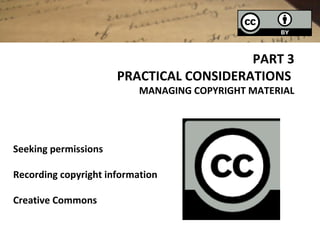Perth Museums - Part 3 managing copyright material
- 1. PART 3 PRACTICAL CONSIDERATIONS MANAGING COPYRIGHT MATERIAL Seeking permissions Recording copyright information Creative Commons
- 2. Seeking permissions Develop a template for permitted uses of copyright materials i.e. Series of tick boxes for the copyright holder listing permitted uses of material: publication online, use in catalogue, marketing materials, etc See template provided Y is for Yvert & Telier by cliff1066 http://www.flickr.com/photos/nostri-imago/3499126175/
- 3. Keep detailed copyright records Contact details for copyright holder Cataloguing - Set expiration dates on electronic records of items, enable search query on copyright status – i.e. an automatically updating database of public domain materials Centralised storage of permissions
- 4. Licence your own copyright material under creative commons Encouraging copyright owners to allow others to share, remix and reuse their material legally. Attribution CC BY Attribution-Share Alike CC BY-SA Attribution-No Derivative Works CC BY-ND Attribution-Noncommercial CC BY-NC
- 5. Benefits CC licences provide global recognition – Flickr, Revver, Blip.tv, as well as Google and Yahoo! CC specific search engines CC licences contain licence-specific technical code, making it easy for other users to search for CC licensed content Supports community building, access to materials, culture of sharing Choosing a licence: http://creativecommons.org/choose/
- 6. More information on creative commons licensing creative commons australia - http://creativecommons.org.au/ Collections of CC licensed material: Flickr Europeana Fotopedia Google Google Images Jamendo Open Clip Art Library YouTube Search criteria – “only images labelled for reuse’. Searching CC content on Google Wikimedia Commons SpinXpress
- 7. Thank you Ellen Broad Copyright Law and Policy Adviser t: 02 6262 1273 Australian Libraries Copyright Committee w: digital.org.au Australian Digital Alliance e: ebroad@nla.gov.au
Editor's Notes
- #5: The rights are: Attribution of authorship Share Alike – which requires derivative works to distributed under similar licence terms Noncommercial – which allows only noncommercial uses; and No Derivative Works – which allows all uses other than adaption or changes to the work The most important thing to understand about creative commons is that it does not strip material of copyright, it is a voluntary system that allows people to share and reuse copyright material through the use of generic licences.
- #6: Refer to factsheet
- #7: Refer to factsheet
- #8: Refer to factsheet






